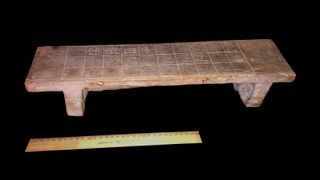Researchers have it that the senet game board which dates back some 5,000 years to Egypt’s first dynasty may give clues to ancient Egyptian view regarding the soul and the afterlife.
The game, according to the researchers, who studied the senet board also known as the San Jose game board at the Rosicrucian Egyptian Museum in San Jose, California was played on a board with 30 squares arranged in a 3-by-10 rectangle.
Although its precise rules are lost to history, they reckon players had to move a set of pawns across the board, with moves determined by throws of a set of two-sided sticks. The squares were blank except for squares 26 to 29, which contained the same progression of symbols: one for goodness, one for water, one for the number three and one for the number two.
The game must have been developed by the first dynasty but by the era of the New Kingdom of Egypt, which began in about 1550 B.C., these game boards had acquired a religious symbolism, appearing in the Egyptian Book of the Dead. The game seemed to represent the soul’s journey through the afterlife. Over time, the markings on senet boards also became more elaborate.
Walter Crist, an anthropologist at Maastricht University in the Netherlands, writing in a new paper published in The Journal of Egyptian Archaeology said there are major gaps in the historical record of senet. Whereas there are tomb carvings and paintings that show game boards and date from between the fourth and sixth dynasties (a span of more than 400 years, between 2613 B.C. and 2181 B.C.), no archaeologist has ever found a game board known to date from this period.
While the exact age of the board is unknown, it was purchased found from a British antiquitarian’s collection in 1947 and was probably taken from Egypt before the advent of modern archaeology according to Crist who also observes that although the board is wooden, it has never been radiocarbon dated.
“That style was intriguing. Over the long history of senet, the board orientation changed. For most of ancient Egypt’s history, play started on the top left of the board and ended with the decorated squares on the bottom right. For a period during the Middle Kingdom, though, the decorated squares were placed at the top of the board and play switched to starting on the bottom right and ending on the top left.”

(Image: © Walter Crist)
Another thing about the San Jose game board is representation of elements from various kingdoms. An example being its style shown in Middle Kingdom orientation yet its decorated square markings being more complex than those on other Middle Kingdom game boards. By the New Kingdom, those same squares might contain depictions of two or three gods, or two or three ba birds, representing the soul according to Crist.
The San Jose board is marked with cursive hieroglyphic writing depicting a symbol for goodness, a symbol for water, three seated men and two seated men. The closest examples to such markings are found on a board from the tomb of Hatshepsut, the female pharaoh who reigned during the 18th dynasty between 1478 B.C. and 1458 B.C.
“The Middle Kingdom orientation and New Kingdom decorations suggest that the board at the Rosicrucian Egyptian Museum was a transitional step between simple senet games and the more decorative and religiously relevant games of later years,” Crist wrote.
Crist further wrote radiocarbon dating could help nail down the age of the board and confirm whether it is, in fact, a gamer’s missing link.










